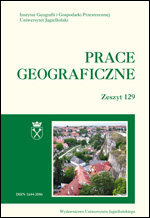Zmiany liczby i poziomu segregacji obcokrajowców w Bremie oraz uwarunkowania ich rozmieszczenia przestrzennego
Changes in the number of foreigners and the determinants of foreigner segregation in Bremen
Author(s): Mirosław Wójtowicz, Natalia FigórskaSubject(s): Cultural Essay, Political Essay, Societal Essay
Published by: Wydawnictwo Uniwersytetu Jagiellońskiego
Keywords: Bremen; foreigners; spatial segregation; dissimilarity index
Summary/Abstract: The aim of this study is to determine changes in the size and structure of the main ethnic groups of foreigners living in Bremen and to calculate the changes in the level of segregation within these groups, as well as in relation to the total population of this city and the German population in the years 1979–2010. For detailed research the four largest groups of foreigners were selected: Turks, Poles, citizens of the “old EU” (EU 15) and citizens of the countries constituting the former Yugoslavia. Index of segregation (IS) indicates a relatively low level of spatial segregation of foreigners in Bremen and in the years 1979–2009 its values decreased only slightly. Only in the case of Poles and the former Yugoslavs considerable declines were recorded. The highest level of segregation was observed in the case of the Turks. This minority, in comparison to other groups of foreigners, also shows the greatest tendency to isolate, which is confirmed by high values of index of dissimilarity (ID). Immigrants from Turkey, Poland and the former Yugoslavia usually concentrate in areas with lower rents and multi-family buildings located in areas filled with post-war housing blocks outside the city center. Foreigners from the EU 15 countries tend to choose midtown neighborhoods characterized by higher rental prices. Furthermore, their level of income allows them to make housing decisions less dependent on the rent costs and may take into account other factors that ensure better living conditions.
Journal: Prace Geograficzne
- Issue Year: 2012
- Issue No: 129
- Page Range: 23-41
- Page Count: 19
- Language: Polish

